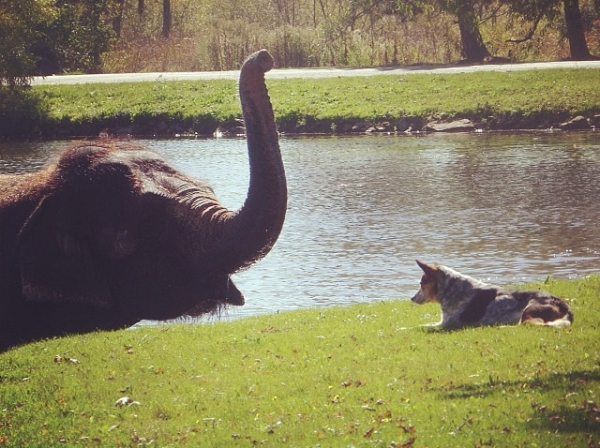Medical science has allowed us to see a woman celebrate her 122nd birthday, an idea that our not-so-distant ancestors probably would have scoffed at in disbelief. With more and more of us seeking advanced veterinary treatments to extend the lives of our pets, could we be on the verge of solving the mystery of canine longevity as well?
Scientists have long tried to discover the key to lasting life. Aristotle even weighed in on the subject in 350 BC with his theory about moisture content. He believed that since larger animals contained more water, they took longer to “dry out” than their smaller cousins. This theory, and many others have been tested and disproved over time.
Steven Austad, a biogenterologist at the University of Alabama in Birmingham is a believer in one of the more recent theories- size matters when it comes to survival. Basically, the bigger the animal, the longer it lives.
[bp_related_article]
In nature, large animals like elephants have far less predators than say, field mice. Over time, larger animals evolved to develop slowly and more thoroughly, reproducing later in life. The little guys who found themselves constantly in danger of becoming a meal, adapted by developing rapidly and reproducing early and often.
Things are a little different when it comes to our domestic pets. Cats on the whole, are smaller than dogs. Yet they live an average of 15 years, while our dogs have an average lifespan of only 12 years. This may mean that the ancestors of cats were simply better at avoiding predators, allowing them to evolve heartier bodies than dogs.
Also, canine ancestors were social animals which increased the risk of communicable diseases. The big cats that preceded our house felines tended to be solitary and less likely to contract illnesses from one another.
Cats have an evolutionary advantage in common with two of the smaller animals with longer lifespans that were studied- bats and mole rats. They all have certain traits that increase their survival rates. Bats can simply fly away, mole rats can hide underground, and cats are equipped with sharp teeth and four sets of claws for fending off potential predators.
Interestingly, dogs have the opposite lifespan trend than wildlife like elephants and mice. Within the canine species, the smaller dogs tend to live longer than the larger ones. This may have something to do with the fact that dogs have more diversity than any other species with 184 AKC recognized breeds.
Small breeds like Shih-Tzus and Chihuahuas tend to live nearly twice as long as giant breeds like Great Danes and Bull Mastiffs (averages of 12 years for the little guys and 7 years for the big dogs).
Since most dog breeds are less than a couple hundred years old, evolutionary factors can’t play too much of a role here. More likely growth hormones and speed of growth are involved.
Insulin-like growth factor 1 is a protein responsible for massive growth in large and giant breed dogs. The reason why is unclear, but this protein has been linked to shortened lifespans in the bigger breeds.
Also, large breed dogs grow and develop incredibly quickly in comparison to small dogs, often doubling their weight in a matter of just weeks as pups. This may lead to more frail or “jerry-built” bodies that are susceptible to diseases like hip dysplasia and certain cancers.
Despite these issues, our dogs and cats are living longer than ever before, most likely for the same reasons as us humans- better healthcare and dietary options. Forty years ago the average canine lifespan was about half what it is today.
Unfortunately, some researchers are concerned about the effects of the epidemic rise of obesity rates in our dogs and cats. More than half of US pets are now overweight or obese. They are also exposed to the same carcinogens and free radicals that we are.
So where does medical (or in this case, veterinary) intervention fit in? A drug is currently in the trial phase at the University of Washington’s Dog Aging Project that could potentially extend our pups’ lives by up to 5 years. The Aging Project website emphasizes that they are seeking to extend the amount of years that our dogs are healthy, not prolong the frail senior years.
32 middle aged dogs (between 6 and 9) are being treated with the FDA approved drug, Rapamycin. The drug is currently in use in humans to treat certain cancers and prevent organ transplant rejection. Laboratory trials with mice have shown that it may slow the aging process.
The researchers at UW are tracking the drug’s effect on the 32 dogs’ body weight, activity level, and heart, cognitive and immune functions over a 3 to 6 month period. If the drug is shown to be effective in these dogs and becomes available to the public, it could mean 2 – 3 extra healthy years with our large dogs, and up to 4 or 5 with our little pooches. Successful canine trials may even lead to the use of Rapamycin in cats and other species.
Aside from humans, scientists and medical researchers have far more data to work with on cats and dogs than any other species, making them the perfect research subjects for conquering the mystery of extended life. Continuing to monitor the lifespan trends within these species is a start. Solving the obesity and cancer concerns is another logical step.
With all of the advances on the horizon, it may be reasonable for us to look forward to enjoying longer lives with our treasured pets by our sides. After all, what fun would living to 122 be without them?
















